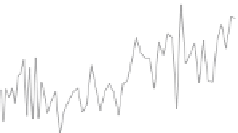Geoscience Reference
In-Depth Information
(a)
Insolation
480
440
400
JJA 12°N
DJF 5°S
1
σ
80
Andes
(b)
5°N
GeoB4411-2
70
% Amazonian Andes
Lowland
80
Andes
(c)
9°N
GeoB7011-1
70
Lowland
% Amazonian Andes
Amazon
% Amazon
80
(d)
12°N
GeoB3938-1
70
Orinoco
LIG
60
110
120
130
Age (ka)
Fig. 2 Paleoclimatic records across the last interglacial (LIG). a Austral summer (DJF at 5
°
S,
black line) and boreal summer (JJA at 12
°
N, grey dotted line) insolation, b proportion of
Amazonian Andean (vs. lowland) material within the terrigenous fraction of core GeoB4411-2
(5.4
°
N, 44.5
°
W, 3,295 m), c same as b for core GeoB7011-1 (8.5
°
N, 53.3
°
W, 1,910 m),
d proportion of Amazonian (vs. Orinoco) material within the terrigenous fraction of core
GeoB3938-1 (12.3
°
N, 58.3
°
W, 1,972 m). The black line above the X-axis highlights the LIG
period, as de
ned by benthic foraminiferal
δ
18
O values
austral summer insolation variations over the last 250 ka (Cheng et al.
2013
).
Therefore, the increase in austral summer insolation throughout the LIG (Fig.
2
a)
enhanced the ocean-land temperature gradient and moisture transport, thereby
intensifying precipitation over the Amazon basin. Enhanced rainfall over South
America and the adjacent ocean led to the reduced sea-surface salinities (SSS) that are
observed close to the Amazon mouth and advected further northward at 115 ka BP
compared to 125 ka BP (Fig.
1
c). Strong strati
cation of surface waters indicated by
18
O records at 5
planktic foraminiferal
N (not shown) supports this result.
While model and proxy data suggest increasing Amazon precipitation and runoff
across the LIG, the core at 12
°
N and 9
°
δ
N exhibits a decrease in the relative proportion of
Amazon (vs. Orinoco) material that is centered around
°
119 ka BP (Fig.
2
d). The
model also simulates reduced precipitation and runoff in the Orinoco basin at
115 ka BP compared to 125 ka BP (Fig.
1
a, b), which agrees with the decrease in
boreal summer insolation (Fig.
2
a) but seems to disagree with the relative increase
in Orinoco input at 12
°
N (Fig.
2
d). In order to reconcile these findings, we suggest
that surface ocean currents, which redistribute freshwater input from the Amazon
*





































































































































































Search WWH ::

Custom Search